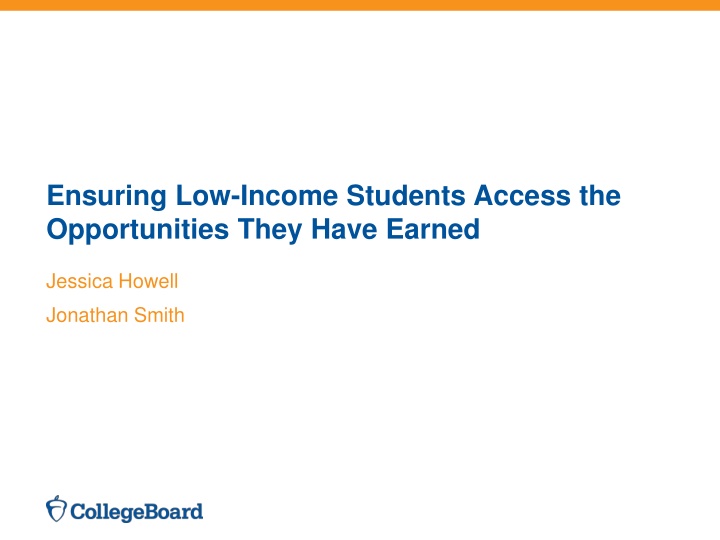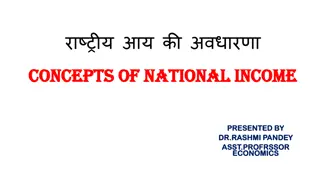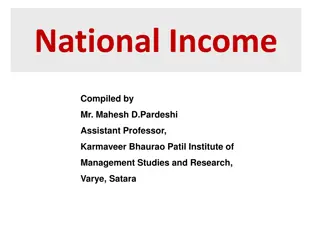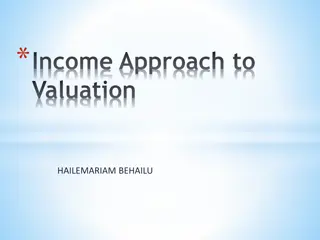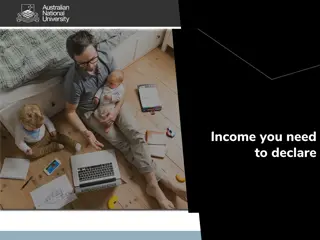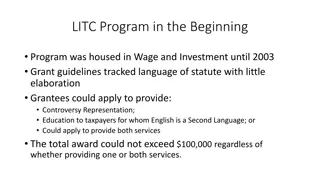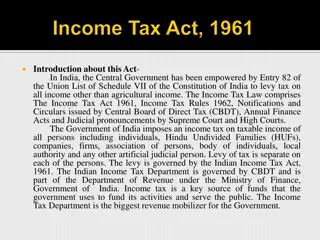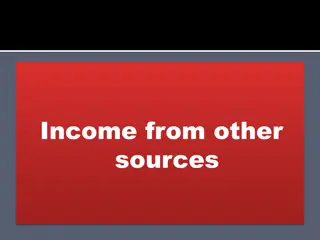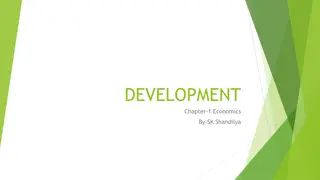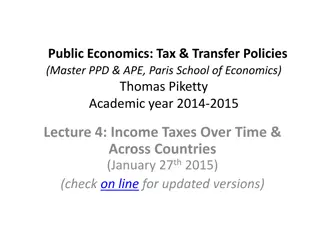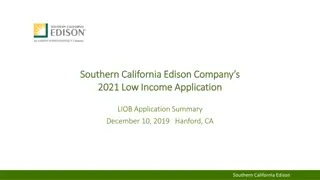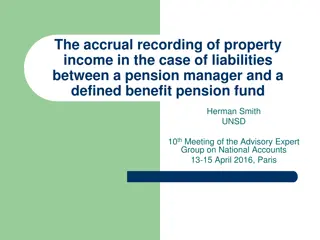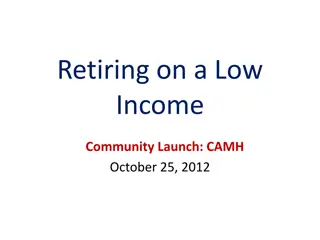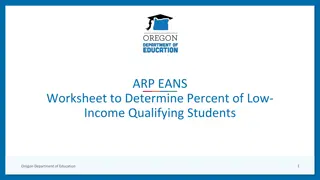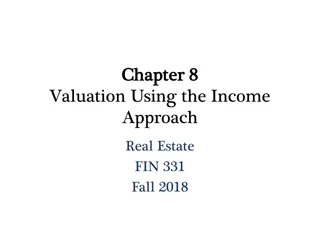Ensuring Access to Opportunities for Low-Income Students
Policy Research team at The College Board is dedicated to identifying and implementing evidence-based activities to support low-income students' access to higher education. The Access to Opportunity program aims to address enrollment gaps by focusing on affordability, academic preparation, and process complexities. Evidence-based initiatives include programs like Realize Your College Potential and Apply to 4 or More, targeting high-achieving, low-income students and those on-track for college. Social media outreach experiments are also being conducted to support these efforts.
Download Presentation

Please find below an Image/Link to download the presentation.
The content on the website is provided AS IS for your information and personal use only. It may not be sold, licensed, or shared on other websites without obtaining consent from the author.If you encounter any issues during the download, it is possible that the publisher has removed the file from their server.
You are allowed to download the files provided on this website for personal or commercial use, subject to the condition that they are used lawfully. All files are the property of their respective owners.
The content on the website is provided AS IS for your information and personal use only. It may not be sold, licensed, or shared on other websites without obtaining consent from the author.
E N D
Presentation Transcript
Ensuring Low-Income Students Access the Opportunities They Have Earned Jessica Howell Jonathan Smith
Policy Research at The College Board + Interdisciplinary team - Economics, education, measurement, political science, psychometrics, public policy, sociology + Team goals - Identify and conduct rigorous social science research - Help organization to implement evidence-based activities at scale - Evaluate whether initiatives worked and for whom - Ensure College Board practices, policies, and policy positions are supported by evidence + Today - Delicate mix of research overview and research specifics 2
Access to Opportunity + New College Board program charged with addressing large gaps in college enrollment, persistence, and completion by income, race/ethnicity, and first generation status. - SAT and AP are examples of other College Board programs, so mission has been explicitly elevated. + Barriers that cause these gaps include issues of: - Affordability - Academic preparation - Process complexities and information asymmetries - Various policies and practices + Policy Research team is the research arm for Access to Opportunity 3
Access to Opportunity: Sample of Evidence-Based Initiatives + Realize Your College Potential - Based on Expanding College Opportunities research by Hoxby & Avery (2013), and Hoxby & Turner (2013) - Targets high-achieving, low-income students with info about balanced application portfolio, affordability, and good match/fit + Apply to 4 or More - Based on application and enrollment research by Smith (2013), Pallais (2013) - Targets students on-track for college with college app fee waivers and messaging about applying to enough colleges + All In - Based on AP effectiveness research by Jackson (2010) and Smith, Hurwitz, & Avery (2015), and descriptive statistics in AP Report to the Nation (2015) - Targets African American, Latino, and Native American students with outreach about enrolling in AP courses in which they have potential for success - One of a variety of very targeted AP expansion/access pilots 4
Outreach via Social Media + Mounting evidence that small behavioral nudges and reminders can have measurable impact even in education - Lavecchia, Liu, and Oreopolous (2015) + College Board has series of pilot experiments - Primarily using Facebook - Several different asks Registering for SAT, sending SAT scores and college applications, general college planning, college course registration and payment - Several groups of students Low-income, middle-income, community college students - Several partners involved Community colleges, Harvard s Center for Education Policy Research and other external researchers, numerous College Board teams 5
Why Facebook? + Great reach + Can use student email addresses to advertise (custom-audience) - Ads can be extremely targeted + Facebook has been shown to matter in other contexts - Emotional and voting experiments + Ads are relatively inexpensive - Return to online ads is open question (Blake, Nosco, and Tadelis, 2014)) + However, notoriously low click-through rates - But perhaps exposure has an effect? - Open question as to how online platforms affect offline behavior - Need an experimental design 6
General Experimental Design + Find College Board students whose behavior we want to influence + Select students with valid email addresses + Determine whether they have opted-in to receive info from us - Approximately 50% of students + Randomize students into control and treatment groups + Upload emails to Facebook - Approximately 50% of emails can be found We do not know which emails are found ITT estimates + Send ads to students + Facebook sends aggregated report on ad exposure and clicks - We can also track if student clicks + Observe outcomes in College Board data (clicks not necessary) 7
Experiment #1 + Can we get low-income students, who are academically on-track for college and who have taken the SAT once before, to re-take the SAT in the fall? - On average, students improve by about 20 SAT points + Targeted two types of students - Used SAT fee waiver the first time took SAT - Did not use an SAT fee waiver the first time (but may be income-eligible) + Approximately 13,000 students in each treatment group - 10,000 in control group + Ads went online and to mobile - Bid extremely high, to get maximum exposure Facebook has limits on how often an ad can be seen in a day 8
Experiment #1 Results + Among students in treatment group (who were found in Facebook) - Approximately 80,000 impressions Some students don t ever see ad Lots of exposure! - Approximately 200 ad clicks 0.24% click-through rate pretty low! - Cost approximately $400 + Relative to control group - No overall effect on whether registered or took SAT a second time - Signs of effects for fee waivered females (2 p.p. 25 percent) Females more likely to see ads + Running related ad for low-income PSAT-takers to take SAT in spring of their junior year 10
Experiment #2 + Partnered with two community colleges + Received list of students (and their emails) who have not taken all necessary steps for coming semester and are either: - First-time enrollees, but in system (i.e., summer melt) - Continuing students without degree (i.e., persistence) + Treatment students saw cycled ads over course of few weeks - Apply for financial aid - Choose courses - Pay tuition - Combination of tasks + No results yet! 11
Experiment #3 + Middle-income students college application patterns more similar to low-income peers than high-income students + Can we get academically on-track middle-income students to complete important tasks and engage in college planning? - Complete FAFSA - Important application deadlines and checklist - How to create - Apply to 4 or More - SAT Score Sends + Links to College Board websites with more information + For subset of students, also used Twitter - Lower email match rate than Facebook + Can only track SAT Score Sends and college enrollment 12
Ensuring Low-Income Students Access the Opportunities They Have Earned Jessica Howell (jhowell@collegeboard.org) Jonathan Smith (jsmith@collegeboard.org)
